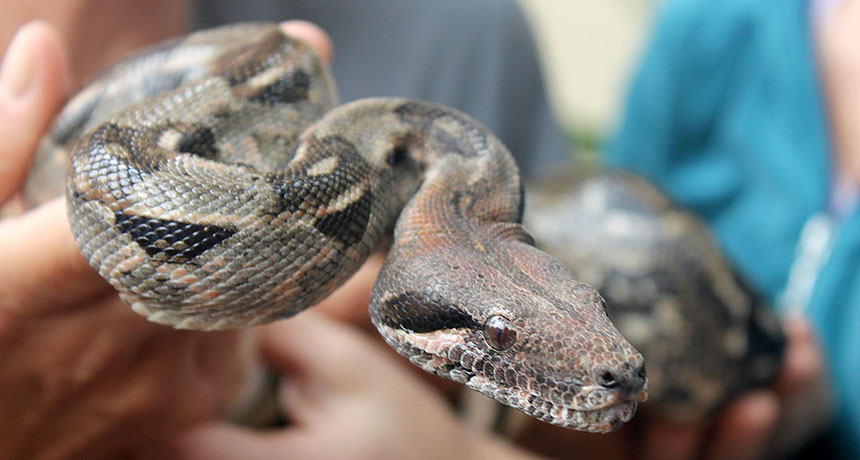Boa constrictors stop their victims’ hearts
The snakes kill by cutting off blood flow, not breath

Boa constrictors, like the one shown here, can squeeze off their prey’s blood flow, cutting the blood pressure of a leg artery in half within mere seconds.
LetsCountTheWays / Flickr (CC BY-ND 2.0)
By Susan Milius
Boa constrictors don’t suffocate their prey so much as break their hearts. A new study finds that these snakes kill like demon blood-pressure cuffs. They squeeze down blood circulation until it stops. Without blood delivering fresh oxygen, the heart, and brain starve.
This means that the idea boa constrictors slay by preventing their prey from breathing is just plain wrong.
Scott Boback emphasizes to his students at Dickinson College in Carlisle, Pa., that these snakes are extraordinary hunters. They don’t need limbs, or even venom, to bring down an animal their own size. “Imagine,” he says, “you’re killing and swallowing a 68-kilogram [150-pound] animal in one meal — with no hands or legs!” As an animal ecologist, Boback studies how different creatures relate to each other. The question of how boa constrictors kill their prey is one example.
For their hunting to succeed, the speed at which these snakes kill really matters. Keep in mind that their prey can fight with claws, hooves or other weapons that the snake lacks. Embracing a creature into heart failure is faster than suffocating it, Boback points out.
The boa is the iconic constrictor. It’s home range spans from Mexico south to Argentina in South America. This snake ambushes birds, monkeys and a wide range of other animals. It launches its attacks in much the same way each time. The snake cinches a loop or two around its victim’s upper body. Then it presses hard enough to starve organs of oxygen-rich blood.
“It’s not some unbelievable amount of pressure,” says Boback. His arms get snaked by a boa now and then. “It stings a little,” he says. “You can kind of feel the blood stop.”
Boback and his colleagues have studied boas’ deadly grip in the laboratory. They use anesthetized lab rats as prey. Within six seconds of looping around a rat, a boa constrictor squeezes enough to cut the blood pressure in a rear-leg artery in half. Blood that should surge through the artery will now lie dammed behind snake coils in the rat’s upper body. And back pressure keeps the rat heart from pumping out new blood. Circulation falters. Eventually, it fails altogether. The boas then release their grip after about six minutes, on average. That’s when they sense their prey are dead.
Boback and his colleagues described their new findings July 15 in the Journal of Experimental Biology.
Once a boa’s prey is dead, the snake swallows it whole. A rat about a quarter of the snake’s weight disappears down the boa’s gullet in a couple of minutes. Moveable bones in the head help the snake open wide enough to let in the meal. So does a dimple of stretchy cartilage that lets the chin open really wide.
People often tell Boback that snake jaws must separate at the back. But that, he notes, is just another serpentine myth.
Power Words
(for more about Power Words, click here)
anesthetize To give a substance (usually a drug) that causes a person or animal to temporarily lose the ability to feel pain. Substances that anesthetize are called anesthetics.
animal ecology A branch of biology that deals with the relations of animals to one another and to their physical surroundings. A scientist who works in this field is called an animal ecologist.
artery Part of the body’s circulation system, these tubes carry blood from the heart to all parts of the body.
blood pressure The force exerted against vessel walls by blood moving through the body. Usually this pressure refers to blood moving specifically through the body’s arteries. That pressure allows blood to circulate to our heads and keeps the fluid moving so that it can deliver oxygen to all tissues. Blood pressure can vary based on physical activity and the body’s position. High blood pressure can put someone at risk for heart attacks or stroke. Low blood pressure may leave people dizzy, or faint, as the pressure becomes too low to supply enough blood to the brain.
boa constrictor A species of large snake that is native to tropical areas of Central and South America. It kills prey by coiling around its victim and squeezing.
cartilage A type of strong connective tissue often found in joints, the nose and ear. In certain primitive fishes, such as sharks and rays, cartilage provides an internal structure — or skeleton — for their bodies.
circulation (in biology) A term that refers to the pumping of blood through the arteries, and smaller types of vessels (and from there into other organs and tissues).
gullet The tube that carries food from the mouth to the stomach.
icon (adj. iconic) A person, thing or idea that is an ideal representation of some category. For instance, the picture of a printer on a Web page is an icon symbolizing the printer you will use to print the page. yrannosaurus rex might be viewed as the icon of meat-eating dinosaurs.
prey (n.) Animal species eaten by others. (v.) To attack and eat another species.
serpentine Relating to serpents or snakes.
suffocate To be unable to breathe, or to cause a person or other animal to be unable to breathe.
venom A poisonous secretion of an animal, such as a snake, spider or scorpion, usually transmitted by a bite or sting.







